Choosing a climbing harness used to be a matter of plumping for the lesser of two, maybe three, crotch and hip-nipping evils. Many of the earliest models could, in fact, have moonlighted as remarkably effective instruments of torture. Given that their purpose was one of the life-saving variety, relationships between the user and the used tended to be fairly love-hate. Luckily for us, however, at some point in the history of the climbing harness, some saint of the climbing fraternity decided they’d suffered one wedgie or chafed hip or thigh too many and determined to do the intimates and waists and upper legs of all posterity a favour by upgrading things a little. As a result, in terms of comfort, versatility and general user-friendliness, these days we are spoiled – both by the relative luxury and functionality of modern harnesses and for choice.
To spare you the effort of trawling through the countless options out there and aligning them to your requirements, Cool of the Wild is here to take you through a need-to-know rundown of harness types, and offer our selection of the best climbing harnesses for whatever you might be getting up to!
- FAQs when choosing the best climbing harnesses
- The 8 best climbing harnesses in 2024
- How to choose a climbing harness for:
- Parts of a climbing harness
Summary of the best climbing harnesses in 2024
This quick overview of the best climbing harnesses gives you a basic idea of which harnesses are leading the way in the climbing world, with more detailed info on each harness later in the article. And if you really want to understand how to choose a great climbing harness, then skip to the bottom section of the article.
Disclaimer: We use affiliate links and may receive a small commission on purchases.
| Product | Summary | Weight | Cost |
|---|---|---|---|
| Black Diamond Solution Harness | Lightweight, eco-conscious | 330g (11.6oz) | $ |
| Edelrid Moe Harness | Lightweight, eco-conscious all rounder | 326g (11.5oz) | $ |
| Mammut Togir 3 Slide 2.0 Harness | Lightweight, eco-conscious all rounder | 367g (13oz) | $$ |
| Black Diamond Momentum | Comfortable and lightweight for sport and trad climbing | 302g (10.7oz) | $ |
| Petzl Altitude Harness | Lightweight for mountaineering and ski touring | 150g (5.3oz) | $$ |
| Wild Country Mission | Sport climbing | 425g (15oz) | $$ |
| Petzl Corax | Good value all-rounder | 539g (19 oz) | $ |
| Metolius Safe Tech Deluxe | Trad climbing, very safe | 567g (20 oz) | $$$ |
| Singing Rock Garnet | Great value all-rounder | 400g (14 oz) | $$ |
FAQs when choosing the best climbing harnesses
Some climbing harnesses will come with a recommended retirement age. If there is no recommendation then a harness that shows no signs of wear and tear should be retired after 7 years.
However, you should stop using a climbing harness at the first signs of visual wear and tear. Even the smallest frays and tears can compromise the strength of a harness.
You pay anything from around $45 to $160 for a good climbing harness. The Petzl Corax, Edelrid Moe and Black Diamond Momentum all offer excellent value and are ideal low cost options if you are looking for an all-rounder climbing harness, or if you are just starting out.
The 8 best climbing harnesses in 2024
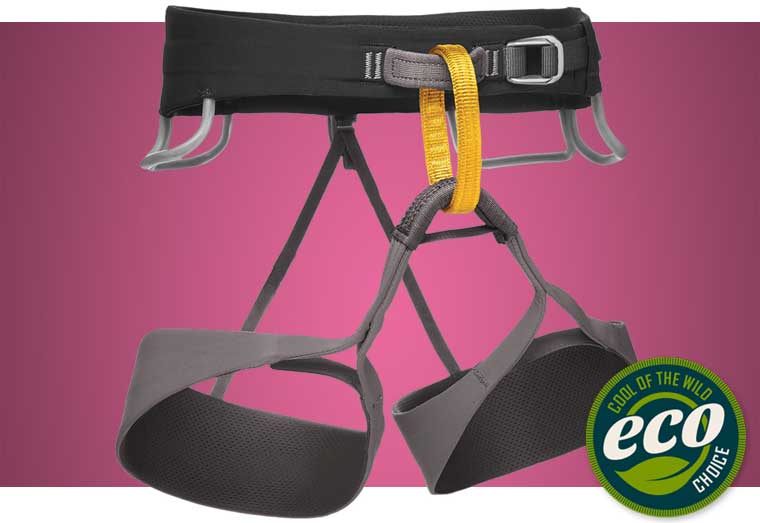
Black Diamond Solution Harness
The Solution Harness by Black Diamond is an ideal option for sport climbers working projects. It offers unrivalled comfort thanks to the Fusion Comfort Technology for excellent load distribution. The result is long-lasting comfort for both belayer and climber with less pressure placed on sensitive areas.
From an eco-friendly standpoint, this lightweight, workhorse of a harness is constructed with Bluesign approved fabric to minimise its environmental impacts.
Pros
- Perfect for sport climbing
- Plenty of gear storage loops for sport climbing only
- Simple design
- Very comfortable
Cons
- No leg loop adjustments
Find the latest price on:
Amazon | REI

Edelrid Moe Harness
Best for: Sport and general vertical adventures
The Moe Harness is a new member of Edelrid’s Bluesign certified harness collection, putting it alongside the Black Diamond Solution and Mammut Togir in terms of eco-conscious appeal.
On the climbing front, it’s comparable to the Mammut Togir as a do-it-all harness that offers comfort and functionality in equal measure, as well as a similar replacement indicator on the tie-in loop. It does lack a gear haul loop and some may find the leg adjustment system on the elasticated joins a little on the flimsy side. However, it’s a little more lightweight, has a couple of extra features and a slightly kinder price-tag than the Togir.
Extra features include a center fit system which means that the padding moves independently of the tie-in system so that the tie-in point will always sit at the center of your waist, no matter what angle you might find yourself at on the rock (or in the air!). There’s also a small pouch on harness to accommodate an RFID tag.
Pros
- Good comfort with center fit system
- Replacement indicator in tie-in loop
- Lightweight
- Adjustable leg loops
- Ice clip loops and 4 gear loops
- Good value
Cons
- No gear haul loop
- Leg adjustment system is potentially a bit flimsy
Find the latest price at:
REI | Amazon
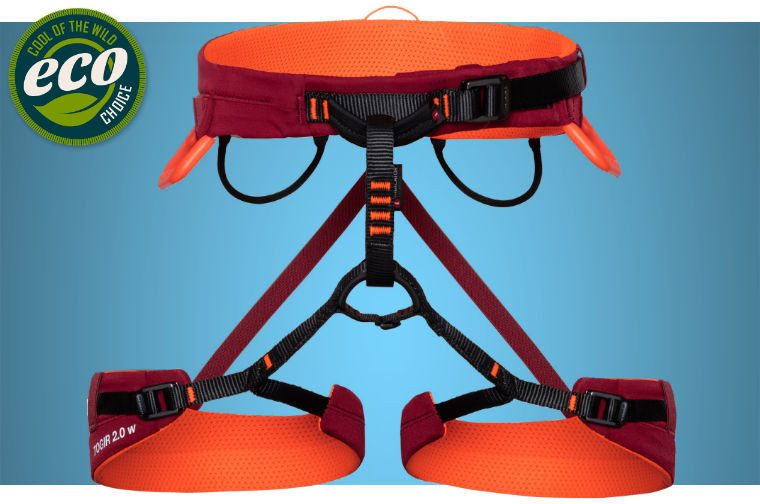
Mammut Togir 3 Slide 2.0 Harness
Best for: All types of climbing
With plenty of well designed features that accommodate a variety of climbing types, the Mammut Togir 3 Slide 2.0 Harness is a superb option for do-it-all female climbers.
Firstly, the adjustable leg loops (which are wider for the female form) make for easy layering in mountain settings. The two ice clipper loops further add to its suitability on ice or alpine routes.
Secondly, there Togir features a 4 kN haul loop for lugging gear up multi-pitch routes, and four gear loops provide enough space for a full trad rack.
Finally, the low weight and slim design of this excellent all-rounder harness offers an excellent comfort to weight ratio for dynamic sport routes to multi-pitch ice climbs, and everything in between.
For general appeal, and like the Edelrid Moe, an indicator in the tie-in loop shows when the harness needs to be replaced. A nice touch for peace of mind when you need it most.
Pros
- Female specific fit
- Has haul loop
- Adjustable leg loops
- Good storage options including ice clipper loops
- Lightweight
- Replacement indicator in tie-in loop
Cons
- Gear loops could be bigger for trad climbers
- Padding is slightly on the slim side
Find the latest price at:
REI | Amazon

Black Diamond Momentum
Best for: Trad and sport climbing
For those who prefer to keep their climbing on rock and away from stuff that melts, the low weight and versatility of the ever-popular Black Diamond Momentum is an excellent option to consider.
Aside from the mountaineering specific Petzl Altitude, the Momentum is the most lightweight harness on our list making it highly appealing for long days on the rock and multi-pitch missions. It also has adjustable leg loops to meet your layering / hanging around requirements. Plus, a haul loop and four pressure-molded gear loops enable trad climbers to rack-up sufficiently.
Despite its low weight, this good value harness still manages to offer decently plush padding and comfort. The result is a harness that is as appealing to beginners as it is to experienced sport and trad climbers.
Pros
- Good value
- Comfortable
- Lightweight
- Good storage options
Cons
- Not suited to mountaineering or ice climbing
Find the latest price at:
REI | Amazon
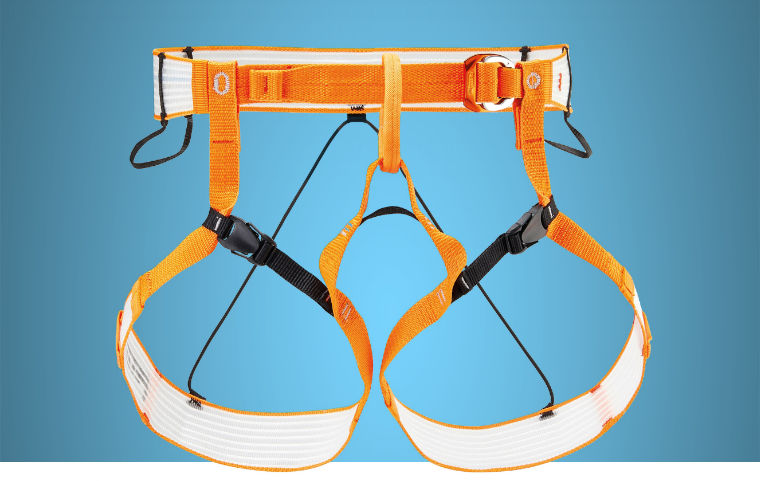
Petzl Altitude Harness
Best for: Trad / sport / general climbing / mountaineering / ice climbing
If you’re looking for a climbing harness for regular rock climbing then skip on past this option, it’s not for you! Weighing in at a miniscule 150g, the Petzl Altitude Harness is by far the most lightweight harness on our list. And with zero padding it’s probably the most uncomfortable too!
Designed specifically with mountaineering and ski touring in mind, this is most certainly not a contender for the all-rounder award. However, for alpine missions when low weight and easy access into it are must-have features, the Altitude wins every time.
Easy clip buckles on the leg loops and a doubleback waist buckle enables you to put the harness on without taking crampons or skis off. Additionally, the leg loops feature a couple of webbing straps to help keep ice screws clipped onto the two gear loops, securely in place.
Pros
- Super lightweight
- Non-step-in design
- Highly packable
- Ice screw retaining loops
Cons
- No padding
- Not suitable for rock climbing
Find the latest price at:
Amazon | REI
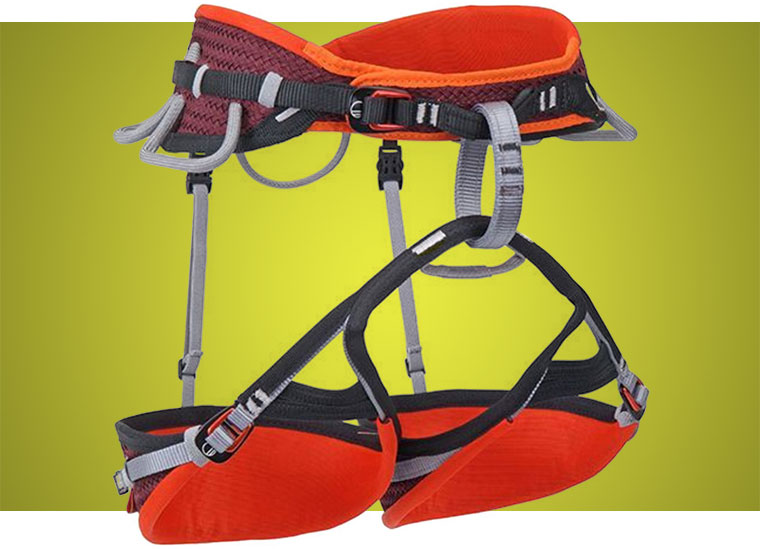
Wild Country Session
The Wild Country Session is a decent contender for the all-rounder award, featuring 4 large gear loops, adjustable leg loops and a rear loop for carrying tools. Due to its innovative V-Flex technology, the Session is also very flexible and lightweight, cutting down on excess bulk by using ventilated padding. All that said, and while classified as an all-rounder by the manufacturers, most users will find this best suited to sport climbing and a little on the heavy side and thick at the waist for alpine adventures.
Pros
- Perfect for sport climbing
- Plenty of gear storage loops
- Not too pricey
- Adjustable leg loops
- Very breathable
Cons
- Just a tad heavy
Find the latest price on:
REI | Amazon | Backcountry
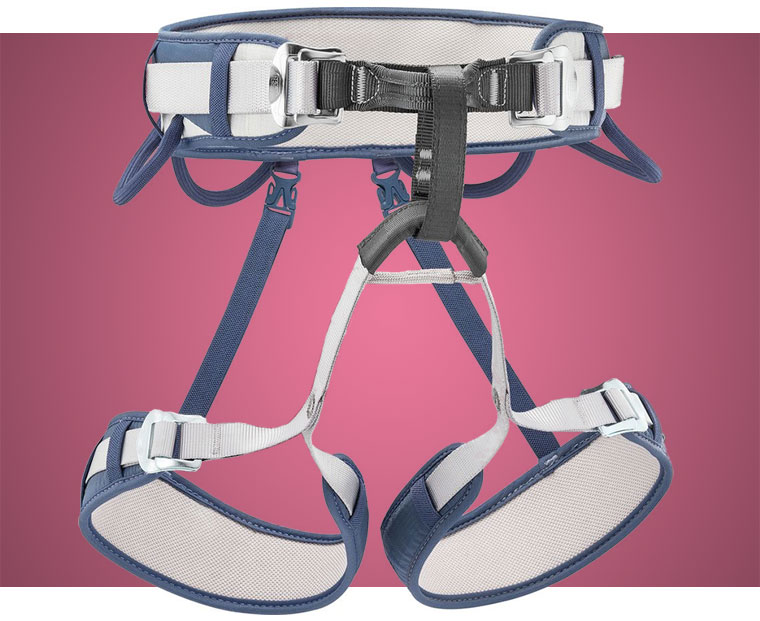
Petzl Corax
Styled as a go-to solution for via ferrata, rock, ice and alpine climbs, the Corax is Petzl’s best answer to the all-rounder. With adjustable leg loops, pressure points lined with soft, cushioning fabric, four spacious gear loops and Caritool Evo compatibility for ice screws, it doesn’t do a bad job of it, either. The Corax is very comfortable and well-made, but compared to its rivals it is just a fraction too heavy and restrictive of movement for high mountain use.
Pros
- Cheap
- High-capacity gear loops
Cons
- Heavy
- Buckles galore may put some off
- Restricts movement when walking
Find the latest price on:
REI | Amazon | Backcountry

Metolius Safe Tech Deluxe
The Metolius Safe Tech Deluxe is a true beast of a harness. While weighing in at a fairly ponderous 567g, it uses every gram remarkably well, doing pretty much everything a harness can do in the most robust and safest way possible. The Metolius comprises four large gears loops, great breathability, foam padding, adjustable leg loops, a duo of belay loops for extra security and minimising clutter on multi-pitch belays or rappels, and Safe Tech webbing and lining, which means that every inch of the material used is fully strength rated. Nice! While all this may be overkill for indoor wall climbing or too heavy for high-mountain excursions, the Metolius comes into its own on trad routes and is super-comfy even when worn all day long. As for competitors, we’re really not sure it has any!
Pros
- Ideal for trad and all-day, multi-pitch climbs
- One of the most safety-conscious harnesses on the market
- Super-handy dual belay loops
- Large gear loops
- Great breathability
Cons
- Heavy
- A touch pricey
Find the latest price on:
REI | Backcountry
How to choose a climbing harness
While there are a multitude of specs, features and functions that largely determine a harness’s suitability, deciding which harness is right for you ultimately boils down to how and where you plan on using it and the type of climbing you prefer. Before we get round to reviewing the best harnesses out there at the moment, let’s take a look at the various uses and applications of a harness and some of the specs that will make one of these your go-to gear for your time on the rock, ice, in the gym or in the high mountains.
Sport or gym climbing
When sport climbing, we are spared many of the considerations necessary at trad, ice and alpine level. We don’t, for instance, need additional features such as haul loops, huge gear loops or adjustable leg loops, and we can also afford to economise on certain features in favour of a bit more comfort and the additional weight that usually entails. The ideal sport or gym/wall harness, therefore, will most likely boast plenty of padding and a sizable waist belt but have fewer gear loops.
Trad climbing
Many of the finer details of a trad climbing harness come down to personal preference, but a few general ‘musts’ are a haul loop, plenty of storage space for nuts, cams and biners, and all-day comfort. With most trad routes taking at least a good few hours, you don’t want anything that’s going to start nipping or not provide adequate back support when hanging or in the case of a fall. Adjustable leg loops are a bonus, allowing you to accommodate layers of clothing in colder weather and enjoy a nice, tight fit on summer climbs.
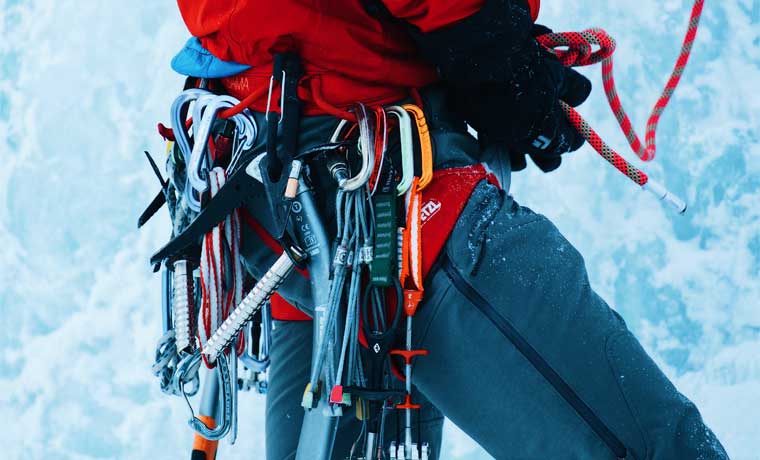
Ice and/or mixed climbing
For those who will be spending more time on the frozen stuff, the desirable features to look for in a harness are fairly easy to enumerate. To accommodate your extra gear and ice-screws, you’ll need a few ice-clip slots, fairly spacious gear loops and a weight-sustaining haul loop. To make sure you can get on all of those extra layers and get in and out of the harness without exposing your feet to the cold or fussing around with laces with cold fingers, adjustable leg loops are an absolute ‘must’.
Mountaineering and Alpine Climbing
Mountaineering and alpine harnesses are defined as much by what they don’t have as by what they do have. The ‘don’t haves’ include a wide waist belt, a chalk bag loop and an abundance of padding. Whereas the ‘haves’ – or ‘must-haves’, rather – include adjustable legs loops (to put on and take off crampons while wearing the harness, and to let you adjust the harness to your layering of clothes), a drop seat to let you answer nature’s calls with as little fuss as possible(!), and some form of accommodation for ice-screws. Given you’ll be carrying the thing in your backpack for a large part of the day, the lighter the harness the better.
The All-Rounder
The true all-rounder climbing harness is something of a holy grail – pretty hard to find and subject to much speculation as to its whereabouts! While many harnesses are claimed to be ‘all-rounders’, the description, in some cases, can be misleading and again will depend largely on personal taste and preferences. Certain aspects of functionality lend themselves to the categorisation, of course, but often the compromises entailed mean individual users might be inclined to disagree with the labelling. To give an example, a well-padded and super comfy gym or trad harness might prove to be a bit too heavy for mountaineering, given that the climber will have to lug it in his or her rucksack for a great part of the journey or, conversely, an ultralight alpine harness might lack the padding and comfort desired by sport or trad climbers who anticipate doing a lot of hanging or rappelling.
Parts of a climbing harness
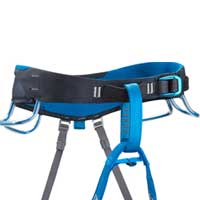
Waist belt
This is usually lightly padded to provide comfort. Waist belts are adjustable with a buckle to one side. Some harnesses have two adjustable buckles on either side of the belay loop.

Gear loops
These are not intended to be used as load bearing attachment points. They are used to carry quickdraws, carabiners and climbing protection when climbing. Most climbing harnesses will have at least two gear loop located on the sides of the harness. However, some harnesses have more than four gear loops.
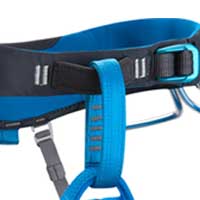
Belay loop
Load tested, the belay loop is the strongest part of a climbing harness. It is only used for for belaying; no ropes should be tied to the belay loop, only carabiners and belay devices should be attached to it.
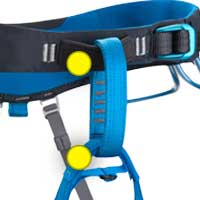
Tie-in loops
These are used for the climber to tie into before attempting a climb. They should not be used to attach a belay device or carabiner to the harness. Both loops should always be used to distribute the wear on the loops creating a stronger, more reliable attachment point.
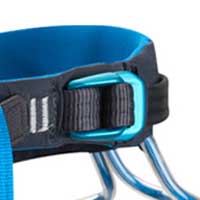
Buckle
The waist buckles of climbing harnesses are usually auto-locking (once they are tightened they won’t loosen with wear). Otherwise, the buckle is designed for the wearer to “double-back” the waist belt webbing to lock off the mechanism manually.
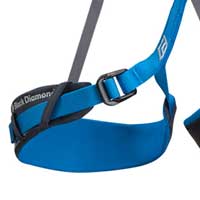
Leg loops
These are usually lightly padded to provide comfort to the wearer. They are kept in place at the back by elastic straps and attached the belay loop via the lower tie-in loop. Leg loops are often adjustable with a buckle, however, some are not adjustable at all.
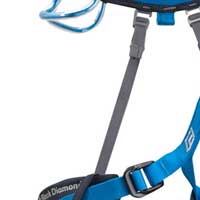
Elasticated straps
These straps connect the leg loops to the back of the waist belt. They are usually adjustable to fit the wearer.
We are, indeed, altogether blessed by the range and quality of climbing harnesses now at our disposal. While the above selection will no doubt include more than one harness you’d like to add to your climbing armory – or maybe even ten – Cool of the Wild hope that we have at least helped to narrow things down and simplified the selection process for when you do your harness shopping!




